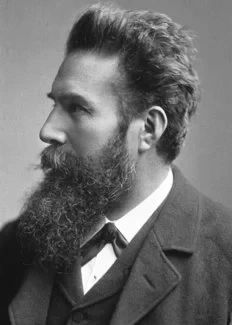Röntgen was born on March 27, 1845 in Lennep, Germany. When he was three years old, his family moved to the Netherlands, Where he went to a boarding school. Although he had skills in making mechanical tools, he did not show any special talent; he loved nature and was fond of roaming in open air and forests.
In 1862 he entered a technical school in Utrecht, but was unfairly expelled from there. He was accused of drawing a caricature of one of the teachers, which was actually done by someone else. In 1865, he entered Utrecht University to study physics. Not Having acquired the qualifications required for an ordinary student, and hearing that he could enter the Zurich Polytechnic by passing the exam, he began studying there as a student of mechanical engineering. He attended lectures given by Clausius and also worked in Kundt’s laboratory. Both Kundt and Clausius had a great influence on his development. In 1869 he recieved his Ph.D and was appointed as Kundt’s assistant at the University of Zurich, and went with him to Würzburg in the same year and to Strasbourg three years later.
In 1874 he was accepted as a lecturer at the University of Strasbourg and in 1875 he was appointed as a professor in Württemberg. In 1876 he returned to Strasbourg as a professor of physics, but three years later he accepted an invitation to the chair of physics at the University of Giessen. After declining similar positions at the Universities of Jena (1886) and Utrecht (1888), he accepted an invitation to the University of Würzburg (1888), where he succeeded Kohlrausch and was placed among his colleagues Helmholtz and Lorenz. In 1899, he rejected the offer of the chair of physics at the University of Leipzig, but in 1900, by the special request of the Bavarian government, as successor to E. Lommel, worked at the University of Munich and despite planning to immigrate to America, he remained in Munich forever.
Röntgen's first work was published in 1870, dealing with the specific heat of gases, and a few years later he published an article on the thermal conductivity of crystals. Among other issues that he studied, we can mention: the electrical and other properties of quartz, the effect of pressure on the refractive index of various liquids, the modification of polarized light planes by electromagnetic effects, the fluctuations of the temperature function and the compressibility of water and other fluids, and phenomena related to the spreading of oil droplets on water.
However, Röntgen's name is most commonly known for his discovery of rays, which he called X-rays. In 1895, he was studying the phenomena associated with the passage of an electric current through a gas at very low pressure, and these studies led him to discovery of X-rays.
He received his Ph.D in physics from the University of Zurich and then worked at the universities of Strasbourg, Giessen and Würzburg (where he conducted the research that led to his Nobel Prize). In 1900, he was transferred to the University of Munich.
In 1895, Wilhelm Röntgen was studying cathode rays. Cathode rays are created when an electric force is applied to two metal plates inside a glass tube filled with noble gases.
Once, although the apparatus was off, he noticed a faint glow on the photosensitive plates that were close to the cathode ray tube. Further investigations showed that this happened due to the impact of an unknown type of penetrating beam on the plates; He called this ray, X-ray because it was unknown. A beam that became a powerful tool for performing physical tests and in-vivo examination. Röntgen won the Nobel Prize in Physics in 1901 for this discovery.
Today, March 27 is the birthday of the X-ray discoverer, Röntgen.




